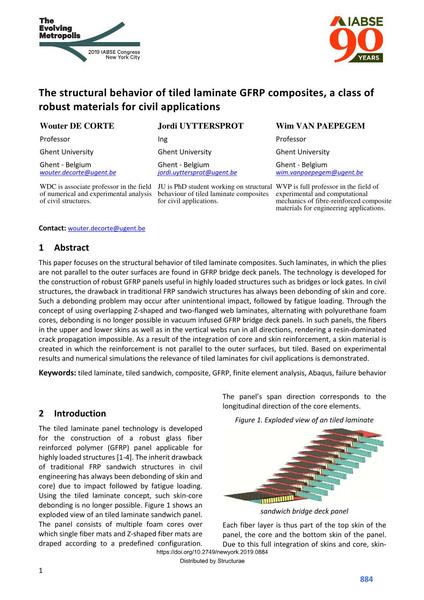The Behavior of Tiled Laminate GFRP Composites, a Class of Robust Materials for Civil Applications

|
|
|||||||||||
Bibliografische Angaben
| Autor(en): |
Wouter De Corte
(Ghent University)
Jordi Uyttersprot (Ghent University) Wim Van Paepegem |
||||
|---|---|---|---|---|---|
| Medium: | Tagungsbeitrag | ||||
| Sprache(n): | Englisch | ||||
| Tagung: | IABSE Congress: The Evolving Metropolis, New York, NY, USA, 4-6 September 2019 | ||||
| Veröffentlicht in: | The Evolving Metropolis | ||||
|
|||||
| Seite(n): | 884-889 | ||||
| Anzahl der Seiten (im PDF): | 6 | ||||
| DOI: | 10.2749/newyork.2019.0884 | ||||
| Abstrakt: |
This paper focuses on the structural behavior of tiled laminate composites. Such laminates, in which the plies are not parallel to the outer surfaces are found in GFRP bridge deck panels. The technology is developed for the construction of robust GFRP panels useful in highly loaded structures such as bridges or lock gates. In civil structures, the drawback in traditional FRP sandwich structures has always been debonding of skin and core. Such a debonding problem may occur after unintentional impact, followed by fatigue loading. Through the concept of using overlapping Z-shaped and two-flanged web laminates, alternating with polyurethane foam cores, debonding is no longer possible in vacuum infused GFRP bridge deck panels. In such panels, the fibers in the upper and lower skins as well as in the vertical webs run in all directions, rendering a resin-dominated crack propagation impossible. As a result of the integration of core and skin reinforcement, a skin material is created in which the reinforcement is not parallel to the outer surfaces, but tiled. Based on experimental results and numerical simulations the relevance of tiled laminates for civil applications is demonstrated. |
||||
| Stichwörter: |
Finite-Elemente-Analyse Verbund GFK ABAQUS
|
||||
